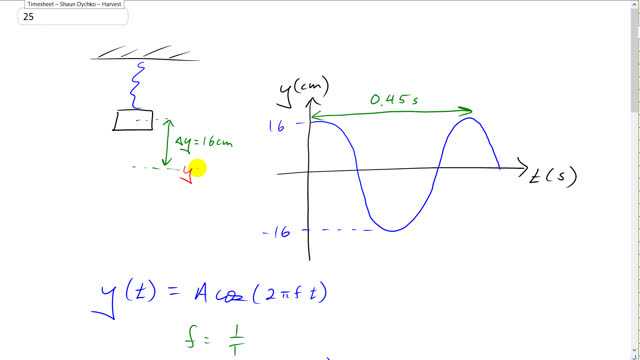
A 1.60-kg object oscillates at the end of a vertically hanging light spring once every 0.45 s.
- Write down the equation giving its position y (+ upward) as a function of time . Assume the object started by being compressed 16 cm from the equilibrium position (where y = 0), and released.
- How long will it take to get to the equilibrium position for the first time?
- What will be its maximum speed?
- What will be the object’s maximum acceleration, and where will it first be attained?

In order to watch this solution you need to have a subscription.
This is Giancoli Answers with Mr. Dychko. We have this hanging mask compressed vertically and it's compressed 16 centimeters with respect to its equilibrium position which we're told is y equals 0. And here's a graph of its position versus time so, I've tried to make the graph line up with this picture here. So, the top of the graph should line up with where the block is at the beginning, at time 0. And then the block will fall according to this graph here and be at this position of negative 16 centimeters at some time here. And then it will return back to the top after 0.45 seconds after it was initially released. Its period is 0.45 seconds. So, we need to find some function that represents this graph. So, the cosine function has its peak at time at 0, at t 0. So, cosine is the function we'll choose instead of sine and we have amplitude here and we have 2π frequency times time goes into the argument for cosine and frequency is 1 over period and so we'll substitute for f and go 2π over period instead there. And then reading off the graph we can plug in numbers, we have 0.16 meters is the amplitude and in the period is 0.45 seconds. So, we plug in that for capital T and when you go 2π divided by 0.45, that works out to 14. And so our function of the vertical position with respect to time is 0.16 meters times cosine of 14 times time. And the amount of time it'll take for this object to get to its equilibrium position for the first time is going to be after one quarter of its period because... I'll show you first on this picture and then I'll show you a second time on this graph, what I mean. So, this object is going to be released and it'll go down here and this, you know, the time it takes to go from here to here is gonna be the answer to our question and that time is gonna be 1/4 of a full period because it's gonna go here and then it'll extend a further 16 centimeters to its very bottom and then return back up and then go back to its initial position. So, and we can see that this represents 1/4 of this total path. And so it's the total period divided by 4. And then on this graph here, it's the time it takes to go from here to here and this is 1/4 of this full picture here. So, it's 1 quarter of 0.45. And so that's 0.45 over 4 which is 0.11 seconds. The maximum speed is 2π times frequency times amplitude and we've got this formula when we modeled simple harmonic motion as the motion of an object going around in a circle with a radius equal to the amplitude and the tangential velocity equal to the v max and the tangential velocity is 2π times frequency times the amplitude, but the amplitude being the radius. OK. So, frequency is 1 over period and since we have period let's substitute that in instead. So, we have 2π times 0.16 meters divided by 0.45 seconds which gives 2.2 meters per second. And then for the maximum acceleration equation 11-10 looks like this. This is acceleration as a function of time and it'll be at a maximum when t is 0 or anything else that makes this cos ωt equal to 0 or equal to 1 or negative 1. Another way to think of it is, is that the maximum of any trig function will be this amplitude and so the amplitude of the acceleration graph is k times the positional amplitude divided by mass. So, there we have that. And we'll need to substitute for this k over m because we don't know what k is. We know that 1 over period is 1 over 2π times square root k over m. This is the frequency formula but I put and 1 over period instead of frequency. And we can solve for k over m by multiplying both sides by 2π. And then square both sides as well. And we get k over m is 4π squared over period squared which we can then substitute in for k over m in the a max formula. So, we have 4π squared and divided by 0.45 seconds squared times 0.16 meters. And that gives 31 meters per second squared. And this will occur when the object is at the ends of its motion so, it'll first occur at its initial release point. So, I guess that's another answer we have to put in here. So, at initial release point. That's when the maximum acceleration will first occur.